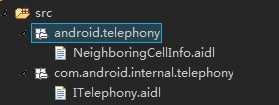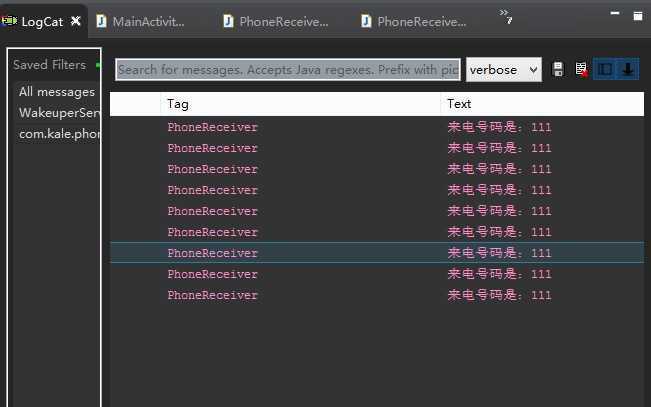标签:
如果要进行来电拦截,首先要定义权限,然后写一个接收来电去电的广播。由于不同机型的问题,动态注册还是静态注册有待商榷,我这里用的是静态注册,模拟器测试通过。
一、申请权限
<!-- 添加访问手机电话状态的权限 --> <uses-permission android:name="android.permission.READ_PHONE_STATE" /> <!-- 拨打电话权限 --> <uses-permission android:name="android.permission.CALL_PHONE"/> <!-- 监听手机去电的权限 --> <uses-permission android:name="android.permission.PROCESS_OUTGOING_CALLS"/>
二、注册广播
<!-- 拨打电话触发的广播 --> <receiver android:name="com.kale.phoneblock.PhoneReceiver"> <intent-filter android:priority="1000"> <action android:name="android.intent.action.PHONE_STATE"/> <action android:name="android.intent.action.NEW_OUTGOING_CALL" /> </intent-filter> </receiver>
三、复制aidl文件
由于高版本的系统中没给出操作电话的api,所以我们要在src文件下新建连个包,放两个文件进去。重要的是ITelephony文件,上面那个文件似乎可以不管它。

NeighboringCellInfo.aidl
/* //device/java/android/android/content/Intent.aidl
**
** Copyright 2007, The Android Open Source Project
**
** Licensed under the Apache License, Version 2.0 (the "License");
** you may not use this file except in compliance with the License.
** You may obtain a copy of the License at
**
** http://www.apache.org/licenses/LICENSE-2.0
**
** Unless required by applicable law or agreed to in writing, software
** distributed under the License is distributed on an "AS IS" BASIS,
** WITHOUT WARRANTIES OR CONDITIONS OF ANY KIND, either express or implied.
** See the License for the specific language governing permissions and
** limitations under the License.
*/
package android.telephony;
parcelable NeighboringCellInfo;
ITelephony.aidl

/* * Copyright (C) 2007 The Android Open Source Project * * Licensed under the Apache License, Version 2.0 (the "License"); * you may not use this file except in compliance with the License. * You may obtain a copy of the License at * * http://www.apache.org/licenses/LICENSE-2.0 * * Unless required by applicable law or agreed to in writing, software * distributed under the License is distributed on an "AS IS" BASIS, * WITHOUT WARRANTIES OR CONDITIONS OF ANY KIND, either express or implied. * See the License for the specific language governing permissions and * limitations under the License. */ package com.android.internal.telephony; import android.os.Bundle; import java.util.List; import android.telephony.NeighboringCellInfo; /** * Interface used to interact with the phone. Mostly this is used by the * TelephonyManager class. A few places are still using this directly. * Please clean them up if possible and use TelephonyManager insteadl. * * {@hide} */ interface ITelephony { /** * Dial a number. This doesn‘t place the call. It displays * the Dialer screen. * @param number the number to be dialed. If null, this * would display the Dialer screen with no number pre-filled. */ void dial(String number); /** * Place a call to the specified number. * @param number the number to be called. */ void call(String number); /** * If there is currently a call in progress, show the call screen. * The DTMF dialpad may or may not be visible initially, depending on * whether it was up when the user last exited the InCallScreen. * * @return true if the call screen was shown. */ boolean showCallScreen(); /** * Variation of showCallScreen() that also specifies whether the * DTMF dialpad should be initially visible when the InCallScreen * comes up. * * @param showDialpad if true, make the dialpad visible initially, * otherwise hide the dialpad initially. * @return true if the call screen was shown. * * @see showCallScreen */ boolean showCallScreenWithDialpad(boolean showDialpad); /** * End call or go to the Home screen * * @return whether it hung up */ boolean endCall(); /** * Answer the currently-ringing call. * * If there‘s already a current active call, that call will be * automatically put on hold. If both lines are currently in use, the * current active call will be ended. * * TODO: provide a flag to let the caller specify what policy to use * if both lines are in use. (The current behavior is hardwired to * "answer incoming, end ongoing", which is how the CALL button * is specced to behave.) * * TODO: this should be a oneway call (especially since it‘s called * directly from the key queue thread). */ void answerRingingCall(); /** * Silence the ringer if an incoming call is currently ringing. * (If vibrating, stop the vibrator also.) * * It‘s safe to call this if the ringer has already been silenced, or * even if there‘s no incoming call. (If so, this method will do nothing.) * * TODO: this should be a oneway call too (see above). * (Actually *all* the methods here that return void can * probably be oneway.) */ void silenceRinger(); /** * Check if we are in either an active or holding call * @return true if the phone state is OFFHOOK. */ boolean isOffhook(); /** * Check if an incoming phone call is ringing or call waiting. * @return true if the phone state is RINGING. */ boolean isRinging(); /** * Check if the phone is idle. * @return true if the phone state is IDLE. */ boolean isIdle(); /** * Check to see if the radio is on or not. * @return returns true if the radio is on. */ boolean isRadioOn(); /** * Check if the SIM pin lock is enabled. * @return true if the SIM pin lock is enabled. */ boolean isSimPinEnabled(); /** * Cancels the missed calls notification. */ void cancelMissedCallsNotification(); /** * Supply a pin to unlock the SIM. Blocks until a result is determined. * @param pin The pin to check. * @return whether the operation was a success. */ boolean supplyPin(String pin); /** * Handles PIN MMI commands (PIN/PIN2/PUK/PUK2), which are initiated * without SEND (so <code>dial</code> is not appropriate). * * @param dialString the MMI command to be executed. * @return true if MMI command is executed. */ boolean handlePinMmi(String dialString); /** * Toggles the radio on or off. */ void toggleRadioOnOff(); /** * Set the radio to on or off */ boolean setRadio(boolean turnOn); /** * Request to update location information in service state */ void updateServiceLocation(); /** * Enable location update notifications. */ void enableLocationUpdates(); /** * Disable location update notifications. */ void disableLocationUpdates(); /** * Enable a specific APN type. */ int enableApnType(String type); /** * Disable a specific APN type. */ int disableApnType(String type); /** * Allow mobile data connections. */ boolean enableDataConnectivity(); /** * Disallow mobile data connections. */ boolean disableDataConnectivity(); /** * Report whether data connectivity is possible. */ boolean isDataConnectivityPossible(); Bundle getCellLocation(); /** * Returns the neighboring cell information of the device. */ List<NeighboringCellInfo> getNeighboringCellInfo(); int getCallState(); int getDataActivity(); int getDataState(); }
四、编写广播接收类——PhoneReceiver
4.1 TelephonyManager
TelephonyManager是用来操作电话的控制器,通过它我们可以对来/去电来绑定监听器
@Override public void onReceive(Context context, Intent intent) { if (intent.getAction().equals(Intent.ACTION_NEW_OUTGOING_CALL)) { // 如果是去电(拨出) } else { TelephonyManager tm = (TelephonyManager) context.getSystemService(Service.TELEPHONY_SERVICE); // 设置一个监听器 tm.listen(listener, PhoneStateListener.LISTEN_CALL_STATE); } }
4.2 处理监听事件
绑定监听器后我们就要根据监听到的不同的情况写不同的代码了
PhoneStateListener listener = new PhoneStateListener() { @Override public void onCallStateChanged(int state, String incomingNumber) { // state 当前状态 incomingNumber,貌似没有去电的API super.onCallStateChanged(state, incomingNumber); switch (state) { //手机空闲了 case TelephonyManager.CALL_STATE_IDLE: break; //电话被挂起 case TelephonyManager.CALL_STATE_OFFHOOK: break; // 当电话呼入时 case TelephonyManager.CALL_STATE_RINGING: Log.e(TAG, "来电号码是:"+ incomingNumber); // 如果该号码属于黑名单 if (incomingNumber.equals("123456")) { // TODO:如果是黑名单,就进行屏蔽 stopCall(); } break; } } };
4.3 挂断电话
public void stopCall() { try { Method method = Class.forName("android.os.ServiceManager").getMethod("getService", String.class); // 获取远程TELEPHONY_SERVICE的IBinder对象的代理 IBinder binder = (IBinder) method.invoke(null, new Object[] { "phone" }); // 将IBinder对象的代理转换为ITelephony对象 ITelephony telephony = ITelephony.Stub.asInterface(binder); // 挂断电话 telephony.endCall(); telephony.cancelMissedCallsNotification(); } catch (Exception e) { } }
4.4全部代码
package com.kale.phoneblock; import java.lang.reflect.Method; import android.app.Service; import android.content.BroadcastReceiver; import android.content.Context; import android.content.Intent; import android.os.IBinder; import android.telephony.PhoneStateListener; import android.telephony.TelephonyManager; import android.util.Log; import com.android.internal.telephony.ITelephony; public class PhoneReceiver extends BroadcastReceiver { String TAG = "PhoneReceiver"; @Override public void onReceive(Context context, Intent intent) { if (intent.getAction().equals(Intent.ACTION_NEW_OUTGOING_CALL)) { // 如果是去电(拨出) } else { TelephonyManager tm = (TelephonyManager) context.getSystemService(Service.TELEPHONY_SERVICE); // 设置一个监听器 tm.listen(listener, PhoneStateListener.LISTEN_CALL_STATE); } } PhoneStateListener listener = new PhoneStateListener() { @Override public void onCallStateChanged(int state, String incomingNumber) { // state 当前状态 incomingNumber,貌似没有去电的API super.onCallStateChanged(state, incomingNumber); switch (state) { //手机空闲了 case TelephonyManager.CALL_STATE_IDLE: break; //电话被挂起 case TelephonyManager.CALL_STATE_OFFHOOK: break; // 当电话呼入时 case TelephonyManager.CALL_STATE_RINGING: Log.e(TAG, "来电号码是:"+ incomingNumber); // 如果该号码属于黑名单 if (incomingNumber.equals("123456")) { // TODO:如果是黑名单,就进行屏蔽 stopCall(); } break; } } }; public void stopCall() { try { Method method = Class.forName("android.os.ServiceManager").getMethod("getService", String.class); // 获取远程TELEPHONY_SERVICE的IBinder对象的代理 IBinder binder = (IBinder) method.invoke(null, new Object[] { "phone" }); // 将IBinder对象的代理转换为ITelephony对象 ITelephony telephony = ITelephony.Stub.asInterface(binder); // 挂断电话 telephony.endCall(); telephony.cancelMissedCallsNotification(); } catch (Exception e) { } } }
五、运行效果
环境:2.2模拟器
接电话时会触发监听器,测试中会出现一次或多次触发监听器。对于要屏蔽的号码进行了完全的拦截,测试成功!
只触发一次的情况:

多次触发的情况:

源码下载:http://download.csdn.net/detail/shark0017/8371787
参考自:http://blog.csdn.net/wangfayinn/article/details/8004023
标签:
原文地址:http://www.cnblogs.com/tianzhijiexian/p/4231007.html